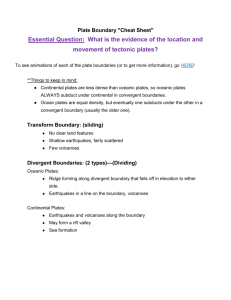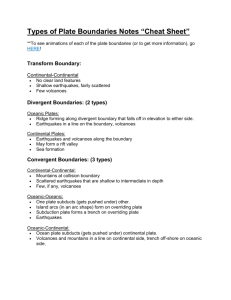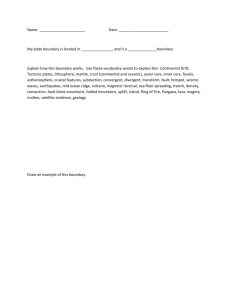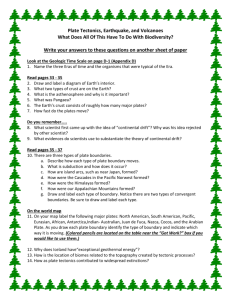Earthquakes and Volcanoes
advertisement
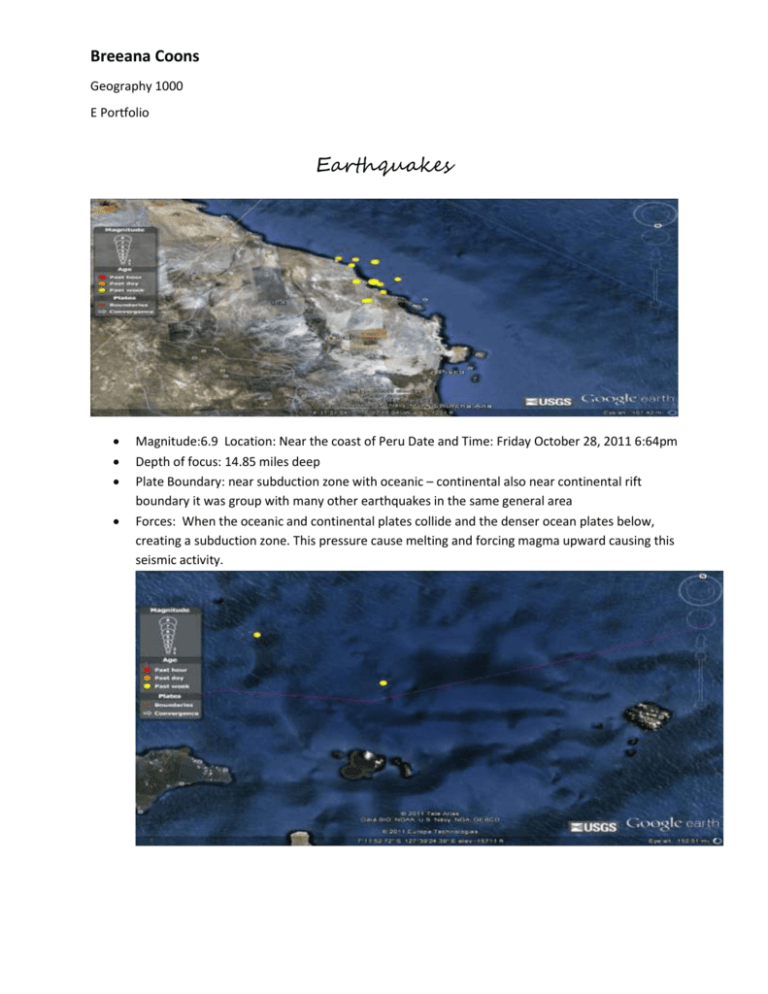
Breeana Coons Geography 1000 E Portfolio Earthquakes Magnitude:6.9 Location: Near the coast of Peru Date and Time: Friday October 28, 2011 6:64pm Depth of focus: 14.85 miles deep Plate Boundary: near subduction zone with oceanic – continental also near continental rift boundary it was group with many other earthquakes in the same general area Forces: When the oceanic and continental plates collide and the denser ocean plates below, creating a subduction zone. This pressure cause melting and forcing magma upward causing this seismic activity. Breeana Coons Geography 1000 E Portfolio Magnitude: 4.8 Location: Kepulauan Barat Daya, Indonesia Date and Time: Nov. 4 at 9:05 pm Depth of focus: 189 .89miles deep Plate Boundary: Oceanic-Oceanic convergence Forces: These two oceanic plates came together causing this earthquake, and most likey created a trench. The extremely high depth of the focus also links toward a trench being created because they create a deep-focus earthquake when they are formed. Magnitude:4.9 Location: New Guinea, Papua New Guinea Date and Time: October 28, 4:50 pm Depth of Focus: 6.21 miles deep Plate Boundary: Continental convergence boundary Forces: The tension that was building up between these two continental plates was finally too much so they finally converged up, causing this earthquake. Breeana Coons Geography 1000 E Portfolio Magnitude: 4.7 Location: South Sumatra Indonesia Date and Time: October 20 2:14am Depth at Focus: 11.56 miles deep Boundary Type: Continental Transform Boundary Fault Forces: These two continental plates tension caused them to finally slip past each other and caused this earthquake, but unlike the rest it did not destroy or create new crust it just caused deformation of things like rivers, roads and fences. Magnitude: 5.1 Location: Southern East Pacific Rise Date and Time: October 31, 4:45pm Depth of Focus: 6.21 miles deep Boundary Type: Divergent Spreading Ocean Rift Forces: This divergent boundary resulted in the ocean spreading and causing this earthquake. You can tell this not only from the boundary type but the depth of the focus, it is shallow and that is what is seen in mid-oceanic ridges. Breeana Coons Geography 1000 E Portfolio Volcanoes Name: Ardoukôba Volcano Type: Cinder Cone Plate Boundary (or hot spot): Continental Rift Boundary Forces: The continental rift boundary in this area caused this volcano. When the plates diverge the land spreads this cinder cone volcano formed. Name: Zukur Volcano Type: Shield Volcano Breeana Coons Geography 1000 E Portfolio Plate Boundary (or hot spot): Hot Spot Forces: As the plates move away from each other they leave hot spots that form volcanoes over the plume. Name: Masaraga Volcano Type: Stratovolcano Plate Boundary Type ( or hot spot): near subduction zone Forces: As one plate subducts under the other we can get volcanoes. That is how this one was formed and it got its shape from the pyroclastic material that built up , creating its steep slopes. Name: Concepción Volcano Type: Caldera Breeana Coons Geography 1000 E Portfolio Plate Boundary Type ( or hot spot): Hot Spot Forces: After a volcano was formed over a plume after the plates had diverted, it collapsed or exploded creating this caldera volcano. Reflection Earthquakes and volcanoes are related in terms of plate tectonics because when plates move the effect is earthquakes and volcanoes. They are the result of all the built up tension being released and the asthenosphere coming up through the surface. There is a reason most earthquakes and volcanoes happen on plate boundaries. As the heat within the core cause convection in the mantle it is moving the plates. Once the tension has built up enough the plates diverge, converge, slip, or sub duct depending on the location and plate type. When they do this they form mountains, destroy lands, create trenches, volcanoes, etc. So without plate tectonics we wouldn’t have earthquakes or Breeana Coons Geography 1000 E Portfolio volcanoes, which some people might think was a good thing. But without them our earth isn’t being built up and our beautiful landscapes are not being formed. The spatial relationship and distribution between volcanoes and earthquakes is easy to see looking at them both on Google Earth. What I noticed is that where there is a clump of earthquakes there is also volcanoes in that same area. However, it does not go both ways. There are volcanoes but no earthquakes around, not to say that for every earthquake there is a volcano. The pattern I observed is that where there is a lot of seismic activity volcanoes are also there usually at a plate boundary. During this course to be honest almost everything you taught us about both earthquakes and volcanoes I did not know. I had no idea what caused either of these to take place, let alone all the different types. Now every-day when I look at our mountains, I’m not thinking about how beautiful they are, I am thinking about how they were formed. They are so big now, but they have been so worn down by weathering and erosion I cannot imagine how big they were 7,000 years ago. The massive earthquakes that must have happened to create all of our surrounding mountains must have been amazing. I enjoyed learning about Yellowstone Park being a super volcano. I had no idea what was going on up there, I have been there once and would love to go again with my new perspective. Another thing I will take away from this class is how important the cycle of the earth being built up and eroded away is. We are so lucky to live with such natural beauty we take advantage of the fact that it took millions of years to look like this. Breeana Coons Geography 1000 E Portfolio Now that I have a strong scientific understanding, my worldview about natural disasters has changed because now I can understand what I am hearing on the news, or reading in a newspaper. Before if I heard a 5.0 earthquake happened in California, I was wondering if that was bad, how bad. Now I know about the magnitudes and the damage each can do. I am no longer in the dark on these disasters; I will know what caused them and how much damage was probably done. This will help me be more empathetic towards places that have gone through a natural disaster because I have a scientific understanding of it instead of an uneducated guess.



